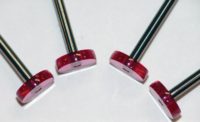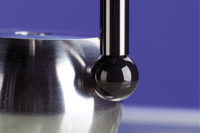CMM Styli






Choosing the right stylus for a coordinate measuring machine probe is a balancing act of size, weight, rigidity and hardness.
As the contact point for a CMM’s discovery and measurement of an object’s various geometries, choosing the right stylus is an important first step towards accuracy.
Tip Material Choices
The stylus itself is composed of three components—base, stem and tip.
The measuring tip usually features a ball, but occasionally is in the shape of a half-sphere, cylinder or other custom shape. Ruby is the most common material for the ball.
“It has some real significant advantages,” explains Q-Mark Manufacturing Inc. President Mark Osterstock. “Ruby is fairly inexpensive because it’s man-made and produced in quantities; it’s a good choice for CMM styli. And they are finished into very high tolerances of sphericity.”
Another big advantage of ruby is that it’s very hard, second only to diamond.
“And it has a relatively low coefficient of friction, meaning it tends not to stick to things when you touch them. So in probing you want a clean touch and getaway, and ruby is really great at that.”
Ruby’s biggest limitation is measuring aluminum objects.
“Ruby will actually accumulate particulars of that material on the ball, and over time will actually build up to the point where there’s a lump on the ball, which is extremely difficult to dislodge or get off,” he continues. “So most people, when they get that buildup, they just throw it away.”
A popular alternative to ruby for use with aluminum is silicon nitride.
“Silicon nitride has all the advantages of ruby, plus it does not suffer the build-up that ruby does,” Osterstock says. “The disadvantage is, it’s significantly more expensive than ruby, particularly because of the machining to put a hole into it (to connect to the stylus stem) is very difficult.”
A more recent innovation, especially for difficult aluminum surfaces, is full diamond.
“In side-by-side comparisons, Diamond!Scan styli were clean where build-up had initiated on both ruby and silicon nitride spheres,” said Laura Bock Carlson, aftermarket product manager of Zeiss Industrial Metrology. “This has a direct correlation to your process stability, and decreases down-time due to sphere inspections and cleaning.”
A third common tip material is ceramic. It is generally used when a large ball—typically larger than 10 mm in diameter—is needed to measure larger parts, such as an engine block.
One drawback to ceramic is it’s not as spherical as ruby or silicon nitride, which can result in less accuracy.
“Usually that tiny drop off in accuracy is overshadowed by the fact that the needed measurement itself is not as precise as you might have with a smaller part used in medicine, for example,” he says.
Occasionally steel balls will be used for tip, primarily for unusual ball sizes.
“Sometimes people need a very specific and unusual diameter ball, and the only material available is hard steel because people make hard steel balls in virtually every diameter,” Osterstock continues. “And they’re readily available off the shelf. So if a customer needs a very specific and unusual diameter ball, often the only alternative is hard steel. The disadvantage with hard steel is it rusts. It takes a lot of care to use hard steel.
Other materials sometimes used for the tip include sapphire, zirconium, tungsten carbide and diamond.
Stem Material Choices
Like the tip, the application and needs of the measuring task determine what material is best for the stem.
Stems are made from steel, tungsten carbide, ceramic or carbon fiber.
Steel is usually used for stems shorter than 30 mm, and with ball diameters greater than 2 mm, according to information from Renishaw.
Tungsten carbide is the best choice when the ball diameter is less than 1 mm and the stylus is up to 50 mm long.
Ceramic is useful when the ball diameter is greater than 3 mm and the stylus is longer than 30 mm, because it offers the stiffness of stainless steel but is a lighter option than Tungsten carbide.
Carbon fiber is used for especially long styli.
“Primarily, what it boils down to is the weight of the material and the length that you’re going out,” says Michael Litwin, CMM business manager, Renishaw. “The farther out you go, the more bending you’ll get in that stylus stem. So to offset that, if you have a very long stylus, you might go with the tungsten carbide.
“The tungsten carbide will be stiffer but also a little bit heavier. It’s always a little bit of a trade-off, but certainly you want to keep it as stiff as possible to get the best performance of the stylus.
“Carbon fiber is lighter, so once you start going out longer, say I need a 200 mm stylus, you start getting into a lot of weight. When you get into a lot of weight, it triggers the probe—false triggers, we call them.”
The brittleness of ceramic has advantages as a mechanical fuse.
“A lot of times you might prefer to have an inexpensive stylus break before it breaks a more expensive probe or the machine,” he explains.
The thermal stability of the stem material is also an important factor.
Of the common stem materials, steel offers the worst thermal stability. Tungsten carbide and ceramic provide average thermal stability. Carbon fiber has the best thermal stability, which is essential in the shop floor environment, adds Bock Carlson.
“Temperature is the biggest foe in metrology – this applies for workpieces as well as for room temperature,” she says. “Temperature is invisible but has a huge effect on result which makes it so tricky.”
The Base
The base holds the stem and connects to the probe arm. It is usually made from either stainless steel or titanium.
“Stainless steel is inexpensive, it’s easy to machine and it doesn’t corrode,” Osterstock says. “It lasts a long time, it’s just an excellent choice for bases. But steel is heavy. Now we’re talking about weight again and every gram counts when you’re approaching the weight limit on your probe system. So in many applications, people prefer titanium.
“Titanium is about one-third lighter than stainless steel, so right off the bat you’re saving significant weight.”
In addition, it’s rigid, corrosion resistant and durable, but more expensive than steel.
Trends
“The drive is for lighter styli,” Osterstock says. “The probing systems are being miniaturized, and as a result they demand lower-weight stylus systems. So we are seeing a real push to lightweight, but very rigid, styli.”
Along with lightweight, he’s also seeing demand for smaller and smaller styli, especially for measuring medical parts.
“Users are also becoming more sophisticated,” adds Bock Carlson. “They are thinking in terms of their measurement accuracy, considering the total application requirements to achieve process stability.”
Looking for a reprint of this article?
From high-res PDFs to custom plaques, order your copy today!









